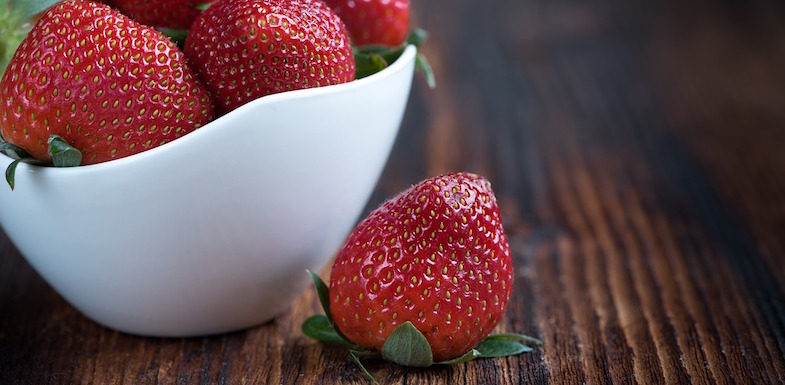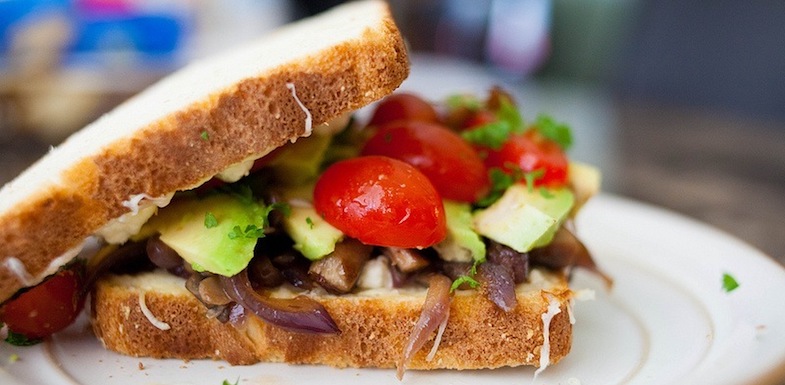
With the flood of fad diets and weight loss programs bombarding you from every side, it’s difficult to figure out what you should and shouldn’t eat. It becomes even more complicated when you’ve got one or more medical conditions, such as chronic pain. Before you know it, figuring out mealtimes can become downright stressful. Eating doesn’t have to be a chore, though. Armed with some basic knowledge, you can make nutritional choices for chronic pain management that help you stay at your healthiest, while reducing your pain levels.
Top 10 food choices you can make for chronic pain management
1. Try to eat something from each food group with each meal
The food pyramid that most of us learned about as kids has now been replaced with the MyPlate guidelines. The food groups are still the same, but the proportions are slightly different. Additionally, the food groups are arranged as though they’re on a plate or place setting, so it’s simple to visualize how much you should each from each food group. Below we talk about important switches you can make at each meal, but for an overall diet task for chronic pain management, try to eat something from each food group with each meal.
Fruits and vegetables
Vegetables ought to take up just over one fourth of your plate. This will help fill you up, which can support weight loss or the maintenance of a healthy weight. In addition, vegetables are packed with different nutrients, so eating a wide variety will provide your body with a lot of different vitamins and minerals. Try to mix up your vegetable intake so that over time, you get as many different nutrients as possible.
Fruit should take up just under a fourth of your plate. When combined, fruits and vegetables should fill half your plate. Again, filling up on fruit instead of high calorie, unhealthy alternatives can support a healthy weight. Fruit is also packed with lots of nutrients. In particular, berries are full of antioxidants, which support a healthy immune system and can even potentially lower chronic pain levels. Eat a big variety of fruit to get a big variety of benefits. When choosing your fruits and vegetables, trying to get a lot of different colors can help you get as many nutrients as possible.
Grains
Grains should fill one fourth of your plate. Whole grains, such as barley, oats, brown rice, or wild rice, are unprocessed and still contain everything that makes them healthy. For this reason, try to make sure that at least half the grains you eat are whole. Whole wheat pasta or whole grain breads can also fill this requirement.
Protein
Protein should take up the last fourth of your plate. Red meat tends to be higher in fat content, and it’s also been linked to increased inflammation, so it ought to be minimized. Other meats, such as lean poultry or fish, are overall healthier. Additionally, meat-free proteins like beans can be used in place of meat if you really want to cut back on fat while increasing fiber.
Dairy
Dairy can be a healthy part of a balanced diet. These products contain a lot of nutrients, but they have been linked to a potential increase in pain with some chronic pain conditions, so pay attention to your body (this is true for any changes you make for chronic pain management). If your pain increases every time you add a dairy product to your meal, consider choosing something like dairy free milks and products (soy or almond are popular), or simply going without.
2. Eat fresh, whole, unprocessed food as much as possible
Highly processed foods usually have most of their nutrients removed. Unfortunately, they also usually have other things added, such as sodium, sugars, or unhealthy fats. Before eating foods like pre-packaged snacks or frozen meals, look for an alternative. For example, instead of frozen breaded chicken tenders, check the meat section for raw chicken breast tenders that you can bake them yourself. It won’t take much longer to cook, and the end result will taste better and be much healthier.
Processed meals or foods are often so high in sodium that switching to fresh, unprocessed foods might leave you thinking your new meals are a bit bland. This will change over time as you adjust to a new, low-sodium diet, but you can also explore the spice section to give your food a punch of flavor. Some spices, such as ginger and turmeric, might even be able to help your chronic pain management.

3. Following a healthier diet doesn’t mean you have to deny yourself
If you’re craving a scoop of ice cream or an order of fries from your favorite fast food place, don’t deny yourself so strictly that you get frustrated, throw in the towel, and go on a binge, completely wrecking your chronic pain management plan. Instead, allow yourself a small, controlled indulgence once in a while.
You can also look for healthier alternatives that still hit the spot when you’re craving your favorite guilty pleasures. When you’re craving a sweet at the end of the day, have a bowl of fruit. To make it extra special, you can add a little whipped cream to sliced peaches or a light drizzle of chocolate to fresh strawberries.
To satisfy your craving for fries, try cutting a potato into wedges, tossing them in olive oil with one or two of your favorite spices, and baking them. If you’re craving potato chips, look into products like Pampered Chef’s “Make Your Own Chips Set” that allow you to quickly make your own chips without adding any grease, fat, or salt.
Also keep in mind that not all fats are bad. The fats found in fish and nuts are very good for you in moderation. In fact, these healthy fats may even help you reduce your chronic pain. We discuss even more healthy swaps you can make later in this post.
4. Don’t forget to think about what you drink
Drinks that contain alcohol and caffeine may exacerbate pain. Some medications may also negatively interact with alcohol, so always talk about this with your doctor while creating your chronic pain management plan. Pay attention to your body’s reaction if you do have alcohol or caffeine. If you notice more headaches after your morning coffee or worse aches after your beer with dinner, consider skipping it.
Additionally, check the label before grabbing a soft drink. Regular sodas are full of sugar with no real nutritional value. Artificial sweeteners, like those found in diet sodas, can often exacerbate pain. Some sports drinks have added sodium. To avoid any unwanted additives in your drink, consider switching to plain water or herbal tea. You can add a squeeze of lemon juice if you need a kick of flavor, or you can even try out water bottles that allow you to infuse real fruit for flavor.

5. Make healthy swaps for breakfast
Instead of: Frozen egg, sausage, and cheese breakfast sandwich
Try: Egg and veggie omelet
The breakfast sandwich may taste delicious, but freezer-stored, pre-prepared food is often heavily processed and stuffed with unhealthy sodium. And while sausage is not the worst thing to eat, it consists of red meat, which tends to cause inflammation and exacerbate chronic pain symptoms.
If you’d like to eat red meat, consider saving it for later in the day and reserving breakfast as a meatless meal.
Instead of the sandwich, try an omelet with your choice of veggies served with a slice of whole-grain bread or side of fruit.
For a long time, eggs had a bad reputation because they were linked to high cholesterol. However, most of the studies supporting that idea included foods that were also high in saturated fat, according to Medical News Today. Subsequent research has showed that eggs are likely neutral on blood cholesterol levels because they’re not high in saturated fat. Eggs also happen to be an excellent source of protein.
While you might not eat eggs every day, eating them several times a week provides numerous health benefits for chronic pain management, including nutrients for a resilient immune system, excellent eyesight, and strong muscles. Amplify the nutritional benefit of the already-healthy egg by adding in tomatoes and spinach, or any other vegetable you desire.
Instead of: Cereal
Try: Oatmeal
Cereals may taste good, but they’re often packed with sugar. Even those boasting heart-healthy benefits or whole-grain ingredients often contain unhealthy and heavily processed additives.
So skip the cereal and try heart-healthy oatmeal. Oats are also anti-inflammatory, an important factor for chronic pain management. The grocer’s aisle is full of oatmeal packets with tempting-sounding flavor combinations, but these are also frequently full of sugar. The healthiest versions are the raw oats you buy and prepare yourself.
Feel free to add in fruit of your choice, like apples or bananas, nuts, and a little honey for sweetener.
6. Take another look at lunch
Instead of: Fast food hamburger
Try: Turkey and cheese sandwich on whole-grain bread
Sandwiches are a fast, easy, and healthy way to eat a satisfying lunch. If you like meat, try eating sliced turkey, which is among the healthier lunchmeats. Try to purchase low-sodium cuts that aren’t filled with salt and other preservatives. As a general rule, the smoother and shiner a piece of meat is, the more processing it has gone through and the fewer health benefits it offers.
Increase the health benefits of the sandwich by layering on lettuce, onion, tomato, and perhaps even a few sprouts. Opt for mustard, which is low in fat, as opposed to mayonnaise. For a treat, you might even add avocado, which offers an abundance of health benefits despite its high (unsaturated) fat content. Skip the cheese if you wish, but one slice is fine for most people. When choosing bread, purchase loafs without high-fructose corn syrup.
If you aren’t a turkey fan, try a sandwich with just veggies. Lettuce, tomato, onion, cucumber, and sprouts topped with a slice of cheese and avocado makes a tasty and satisfying meal.

7. Redo snack time
Instead of: Chips
Try: Trail mix
If you’re craving something salty and crunchy, you may start salivating at the idea of potato chips melting in your mouth. But the hard-to-resist snack is notoriously unhealthy, with each slice of processed potato smothered in unhealthy oils and high in fat and calories.
Instead, try trail mix if you’re putting together a chronic pain management plan. Your best bet is to make your own because store-bought mixes often come with chocolate- or yogurt-covered goodies that may taste good but aren’t much healthier than the chips you so dutifully left on the shelf.
Visit the bulk foods section of your local supermarket and stock up on walnuts, almonds, raisins, and other delicious items. Once home, mix them together and keep on hand for an easy, healthy snack. If you buy dried fruit, try to find options without added sugar.
As a note of caution, nuts are high in fat, so try to keep the portions small. However, the fat is mostly the heart-healthy, unsaturated type, which means nuts are filling and satisfying. Nuts also contain omega-3 fatty acids that fight inflammation, promote heart health, and may reduce chronic pain, according to the University of Maryland.
8. Make better choices at dinner
Instead of: Enchiladas
Try: Freshly made burrito bowls
Take inspiration from Chipotle and create your own easy, delicious, and inexpensive burrito bowl at home.
First, cook up some brown rice. Then, in a separate pot, stir-fry veggies like onion, corn, tomato, peppers (if you’re okay with nightshade vegetables), zucchini, and broccoli in olive oil. Add delicious spices like red pepper flakes, garlic, chili powder, and pepper. Enjoy the vegetables on a bed of rice, along with chopped lettuce and any other toppings you’d like, as long as they’re healthy and not processed!
Instead of: Fried chicken
Try: Roasted chicken and vegetables
Nothing says comfort like fried chicken and mashed potatoes, but when you’re living with chronic pain, every choice counts. Fight pain at the dinner table by roasting your favorite meat instead of frying it. Add taste with spices like thyme or rosemary.
On the side, serve sweet potatoes cooked in olive oil and garlic and your favorite vegetables like asparagus, broccoli, or green beans. Look to spices like lemon, garlic, and rosemary to add flavor.
9. Do-over on dessert
Instead of: Cake
Try: Peanut butter, banana, and chocolate smoothie
Smoothies taste incredibly yummy and, when made at home, you control what goes in them, making this dessert a healthy chronic pain management choice, too.
To make this smoothie, combine in a blender almond milk, a frozen banana, and a tablespoon each of peanut butter and raw cacao powder or unsweetened cocoa powder. Blend until smooth at your desired consistency, adding more almond milk as needed.

10. Be kind
Lastly, don’t go from fast food three times a day to a brand new diet overnight. Altering your eating habits for chronic pain management takes time and effort, so make the changes gradually. It also requires some kindness and forgiveness to yourself when you inevitably make choices that aren’t exactly in line with the “perfect” diet plan.
So, start small. Switch out your vending-machine snacks for fresh fruit or vegetables first. Then choose a meal, such as breakfast, to make healthier. Allow a week or two for each new change to become habit before adding another new change. Changing diet habits requires a small initial effort that becomes easier if you introduce them slowly and as you develop a repertoire of healthy meals to choose from.
What food choices have you made after being diagnosed with chronic pain? Which ones help most with your chronic pain management?
I will try my best – I HATE green food
Hi Ginny — we definitely recommend checking out some of our recipes over on PainDoctor.com! They’re made specifically for pain patients in mind: https://paindoctor.com/tag/recipe/
I will commit to eating as described. Man. Pain will make you do just about anything! 🙂
Unfortunately agreed. We recommend checking out our recipe posts over on PainDoctor for some meal inspiration: https://paindoctor.com/tag/recipe/ Good luck with your new eating!
What is best for peripheral neuropathy? It is moderate to severe. Currently severe.
Hi JC — Thanks for stopping by the blog! We have a full article on peripheral neuropathy here: https://paindoctor.com/conditions/diabetic-peripheral-neuropathy/. If your neuropathy is related to diabetes, we have many diet and exercise tips for that condition that can be found here: https://paindoctor.com/tag/diabetes/. Otherwise, we recommend talking directly to a pain doctor who can help you with your condition, especially since your pain is severe. They can connect you with a licensed dietician as well: https://arizonapain.com/contact/.